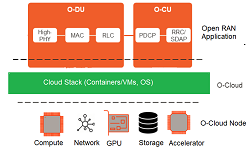Open RAN (O-RAN) Reference Architecture
O-RAN Tutorial
The O-RAN Reference Architecture is designed to enable next generation RAN infrastructures. It is designed with the principles of intelligence and openness, the O-RAN architecture is the foundation for building the virtualized RAN on open hardware, with embedded AI-powered radio control, that has been envisioned by operators around the globe.
The architecture is based on well-defined, standardized interfaces to enable an open, inter-operable supply chain ecosystem in full support of and complimentary to standards promoted by 3GPP and other industry standards organizations.
O-RAN Reference Architecture
O-RAN reference Architecture is shown in below picture

It has following functional blocks:
- Orchestration/NMS layer with Non Real Time RAN Intelligent Controller
- RAN Intelligent Controller (RIC) near-Real Time function layer
- Multi-RAT CU protocol stack Function
- DU and RRU Function
Orchestration/NMS layer with Non Real Time RAN Intelligent Controller
Non-RT control functionality (> 1s) and near-Real Time (near-RT) control functions(<1s) are decoupled in the RIC. Non-RT functions include service and policy management, RAN analytics and model-training for the near-RT RAN functionality. Trained models and real-time control functions produced in the RIC non-RT are distributed to the RIC near-RT for runtime execution.
- O-RAN specification defined an A1 interface between Orchestration/NMS layer with RIC non-RT and eNB/gNB containing RIC near-RT.
- Network management applications in non-RT RIC receives and act on highly reliable data from the modular Control Unit (CU) and Distributed Unit (DU) in a standardized format over A1 Interface.
- AI-enabled policies and ML-based models generated messages in RIC non-RT and conveyed to RIC near-RT.
- The core algorithm of non-RT RIC is owned and deployed by network operators
- This algorithms provides the capability to modify the RAN behaviors based by deployment of different models optimized to individual operator policies and optimization objectives
RAN Intelligent Controller (RIC) near-Real Time function layer
The O-RAN reference architecture provides next generation RRM with embedded intelligence,while optionally accommodating legacy RRM. This resides within the RIC Near RT function layer. The RIC near-RT is completely compatible with legacy RRM and its design is started to enhancing the operational challenging functions such as per-UE controlled load-balancing, RB management, interference detection and mitigation.
This layer has following functions
- It provides new functions leveraging embedded intelligence,such as QoS management, connectivity management and seamless handover control.
- The RIC near-RT delivers a robust, secure, and scalable platform that allows for flexible on-boarding of third-party control-applications.
- RIC near-RT functions leverages a database called the Radio-Network Information Base (R-NIB) which captures the near real-time state of the underlying network
- It feeds various RAN measurements data, to the near-RT RIC to facilitate radio resource management
- It also provides initiate configuration commands to CU/DU.
- The near-RT RIC can be provided by traditional TEMs or 3rd-party players
- RIC near-RT receives an AI model from RIC non-RT and execute it to change the functional behavior of the network
Interface Reference Points (A1 & E2)
- A1, as described above, is the interface between non-RT RIC and modular CU which contains near-RT RIC.
- E2 is a standard interface between the near-RT RIC and CU/DU in the context of an O-RAN architecture.
Multi-RAT CU protocol stack Function
- The function of the Multi-RAT protocol stack supports 4G, 5G and other protocol processing.
- The basic functions of the protocol stack are implemented according to the control commands issued by the near-RT RIC module e.g. handovers
- Multi-RAT CU function shall be deployed on virtualization platform
- This virtualization provides a highly-efficient execution environment for CU and near-RT RIC, with the ability to distribute capacity across multiple network elements with security isolation, virtual resource allocation, accelerator resource encapsulation, etc. benefits
- The current architecture is using existing interface definitions for F1/E1/X2/Xn provided by 3GPP
- This interfaces can be enhanced to support inter operation among multi-vendors and the CU provided by TEMs offer a regional CP and UP anchor for DUs
DU and RRU Function
- The DU and RRU function includes real-time L2 functions, base band processing and radio frequency processing
- The interface between the DU and the RRU provides standard function segmentation, including the DU-RRU lower layer split interface (Open front-haul Interface), and the CU-DU higher layer split interface (F1), which ensures inter-operability between different TEMs
Source:
Related Post:
- Open RAN (O-RAN) Reference Architecture
- O-RAN RU Reference Architecture
- O-RU Category A and Category
- O-RU Digital Front Solution (DFE) Solution from Xilinx
- O-RAN Distributed Unit (O-DU) Reference Architecture
- Cloud RAN Orchestration and Management



